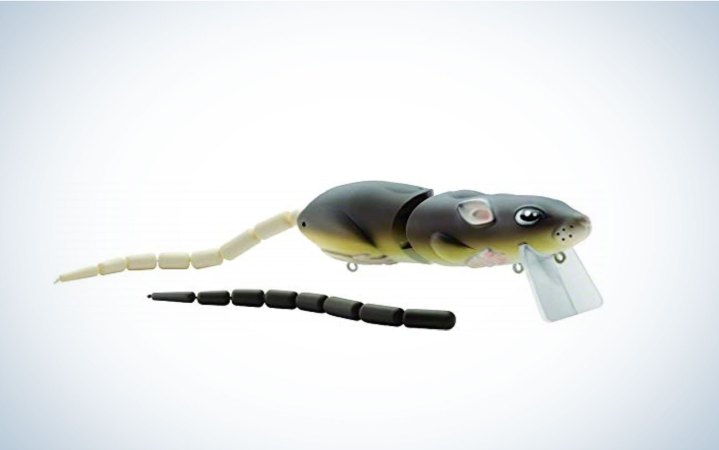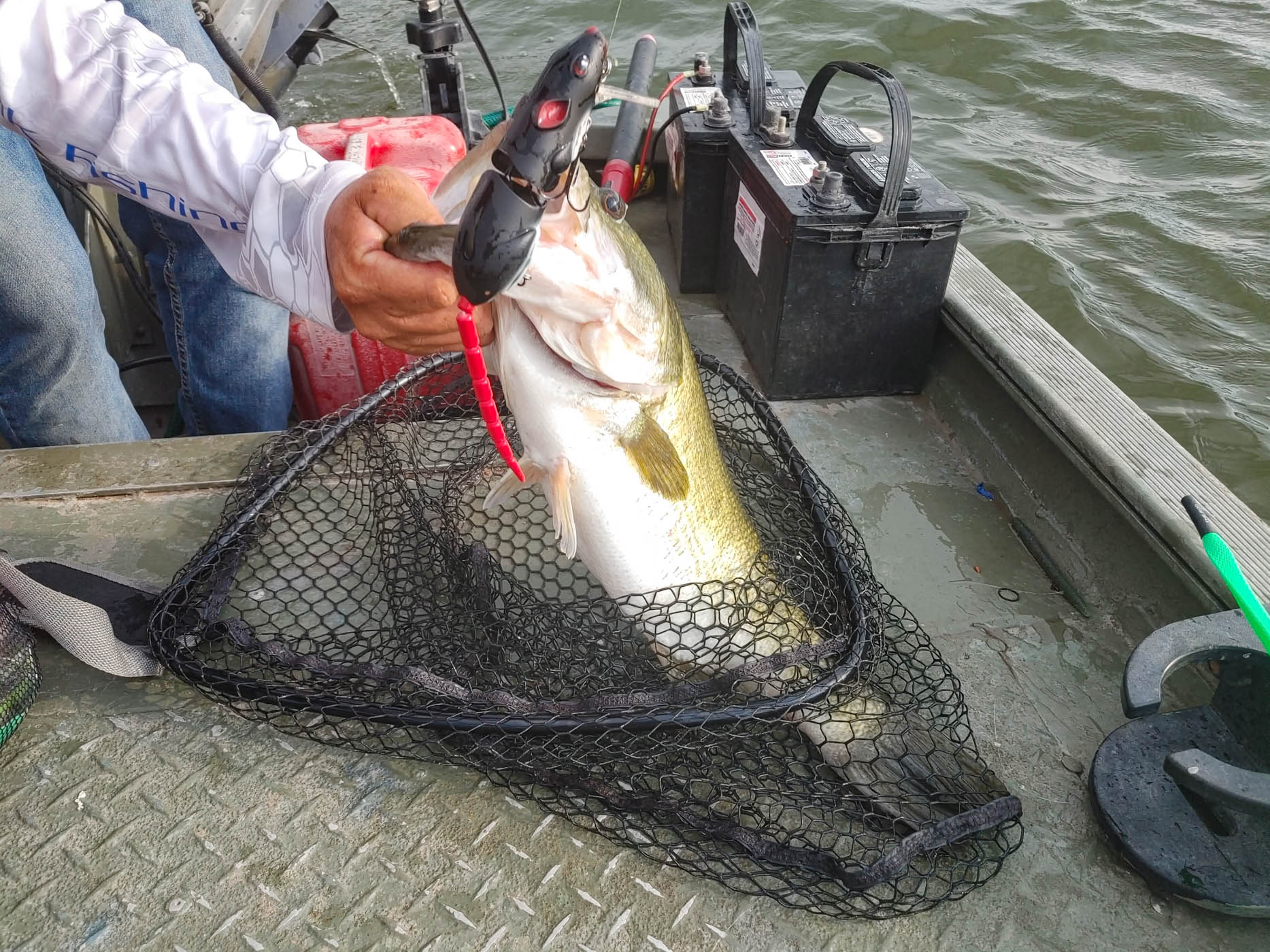Four-time Bassmaster Classic winner Rick Clunn famously said, “If you want to understand the owl, study the mouse that controls him.”
He likely meant it figuratively. To understand bass behavior, it pays to understand the habits of their forage — shad, bluegill, crawfish and the like. Increasingly, though, bass anglers are learning that there’s more truth to what Clunn said then we realized. There are a variety of rat-imitating lures that’ll produce some of the best catches of your life, if only your heart can withstand the incredible violence of the strikes.
It’s not new knowledge that bass – especially largemouths, but the other species as well – will feast on terrestrials if given the chance. Based on speculation or perhaps the occasional well-timed sighting, we’ve offered up lures meant to imitate rodents for decades. Some were anatomically correct, like the Heddon Meadow Mouse. Others were just surface lures with realistic paint jobs, like Arbogast’s chipmunk-themed Jitterbugs and Hula Popper from the “Seein’s Believin’” series. Then along came some of the earliest hollow-bodied frogs with rat colors, like the Mann’s Super Rat, developed by Alabama angler Lloyd Talent to scoot over his home state’s massive grass mats.
But our friends out west weren’t satisfied with those limited-window samples. As big bait culture started, first slowly, then speeding downhill, massive swimbaits and glide baits gave way to big clacking rats.
New Species of Vermin
Early on, it was the garage lure manufacturers near western waters who pushed rat bait designs. Guys like Scott Whitmer at 22nd Century Swimbait Company, Jerry Rago, and a host of other small-scale artistes built jointed rodent imitators that looked like they came straight out of a pet store – or a sewer. They had bodies that totaled 5, 6, or 7 inches long with a piece of plastic worm for a tail that made them 10 or 12 inches total.
Photo by Pete Robbins
Some rat lures could be walked, or even cranked subsurface effectively, but the best amongst them had a nails-on-a-chalkboard sound when they crept along the surface of the water. The combination of a squeaky joint and the rhythmic slapping of the lure’s sections created a cacophony, and the visual of the shimmying lure, with the ultra-natural wide gait of the tail appealed to multiple senses. They have a big presence in the water, and will pull a fish from a distance while also playing to the territoriality of fish holding tight in isolated cover.
Rat Baits
I’m not convinced that every bass that eats a rat-style bait knows what it’s supposed to represent. It’s the fact that it looks alive and real, and potentially threatening, that makes it a likely target. In fact, because it does not resemble their primary forage, it may in some cases be even more appealing.
While those initial small-batch rats often commanded triple-digit price tags, in recent years, I’ve found several that are far less expensive yet seem to get bit just as much. Chief among them is SPRO’s jointed rat, which comes in four sizes from a total length of 5 inches (2.5-inch body) all the way up to 10 inches (5.25-inch body). I’ve been surprised at how many fish of 2 pounds or less will absolutely maul the largest of those four models, even at times when they’ll ignore the smaller ones. While the second-largest (7.5-inches total, with a 4-inch body) is the one that gets me the most bites, the biggest one has produced my largest rat fish.

Some of the other more reasonably priced rats that have performed exceptionally include the PB Rat, Mike Bucca Bull Rat and Evergreen Combat Rat. I’ve really grown to like the PB Rats and Mouse, which come in one-, two-, three- and four-piece versions, with very basic paint jobs but super-annoying (to the bass) sound profiles. They simply get bit.
I stick mostly with black, white and various natural colors, although some anglers swear by gaudy “Morning Dawn” or chrome rats.
When and Where to Throw a Rat Bait

Photo by Scott Einsmann
I love the little SPRO Rats when fish don’t commit to an aggressive walking bait or buzz bait or even a Whopper Plopper. There’s something about the way they have a big presence without being intimidating that gets reluctant bass to break the surface and engulf them. I’ve caught fish with them from the prespawn well into the late fall.
I find the true mega rats to be much more situational, though. First, you have to be in a situation where the bass are not super spooky — or, even better, when they’re downright curious. A 2- to 4-ounce hard bait splashing down on top of a skittish bass is kryptonite, unless they’re in a feeding mode and looking to be called from a distance for an easy meal.
While I’ve caught bass on them when there’s harsh overhead sun, my best windows of opportunity have come in low-pressure situations right before a change in weather. If there’s a storm about to blow through, and the wind is kicking, the big profile still gets noticed through the chop.
Last year in Mexico, I had just such a situation arise late in the evening, and I caught three bass in the 7-pound range around bluff ends and over shallow rock points before getting chased off the lake by lightning.
Obviously, these lures benefit from covering water, where they grab attention and pull fish up. If you can find a grass line, pad line, stretch of riprap, or row of bushes where you can walk them enticingly without getting hung up or fouled, that’s a perfect recipe for success. At the same time, I find that they can often excel around isolated cover, whether it’s a stump, a bush or even a lone bolder. Crash it in aggressively you’ll be surprised at how often the collision gets interrupted.
One other note: I’ve had my best success on these lures on fisheries where the water fluctuates. I can’t prove it, but I’m pretty confident that bass on those waters are used to strange objects and critters entering their living rooms on a regular basis, and look above for a protein-packed snack.
Rat Tackle

Photo by Pete Robbins
While smaller rats can be fished on bass tackle you likely already have, from a medium-heavy baitcaster up to a flipping stick, the larger models require specialized tackle. I want a 7.5 foot to 8 foot baitcaster with a long handle, probably the same rod you use for hard treble hook swimbaits — read our Best Swimbait Rods article for recommendations.
It enables me to make a long cast and keep the rod tip up at a distance so that the lure resists its urge to dive. While it’s a heavy action, I want some flex in the tip, because I most often fish these lures on braided line. Fluorocarbon tries to pull them down, and monofilament doesn’t have the pulling power that I want, although you can get away with 20- to 30-pound mono if you like. I prefer 50-pound braid spooled on a 200 or 300-sized baitcaster, usually anywhere from my 5.8:1 Shimano Tranx (the slowest baitcasting reel that I own) up to a 7:1 reel like a Daiwa Tatula. I have a tendency to over-reel these lures, and the slower speed and high torque can be a winning combination.
Read Next: Are Duck, Rat, and Snake Lures Legit or Gimmicks?
Once that fish is on, get his mouth above the surface with a mouth full of water and hard crank him to the boat. This is not a time for playing him, as a single jump provides exceptional leverage to shake free. Not only do you want to get that fish in the boat, but you want to fire out another cast to experience one of those beastly strikes. They’re addictive, but they’re often only on offer for a short period of time.
